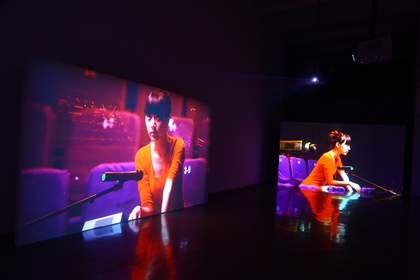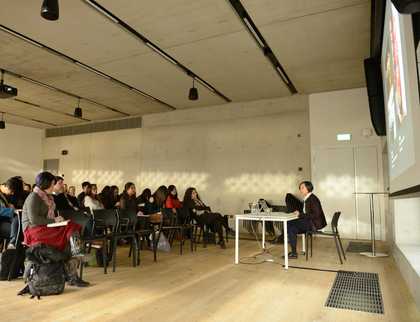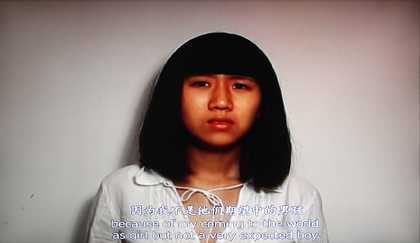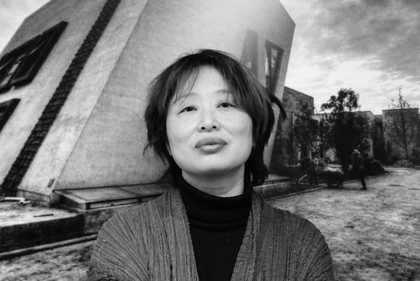
Fang Lu
Image courtesy of the artist
Monica Merlin: Let’s start by talking about your latest work, Cinema. Could you explain the processes both conceptual and technical, of how this piece was made?
Fang Lu: For this new work, I was trying to create a character, a person that could combine various roles – including an actress, a director, an audience and an image producer – all in one woman. Her performance is very minimal and it is in between theatre and film. The setting itself is in a theatre, with a woman sitting in an audience’s seat, watching a live film of herself. Through a control device placed in front of her, she can control the several cameras in the empty theatre, all of which focus on her. The cameras are also connected with a projector, so whatever she allows the cameras to capture is then projected live onto the screen in front of her. So the woman is both the performer and the audience; she only performs her emotion, an emotion that does not provide any narrative or situate itself in any story. I was trying to see if this character could control her emotion and sentiment the same way she could control the cameras and the projector. It sounds very complicated, but in the end it is not about technology. All the devices I used, projectors and cameras, are very common now. They are everywhere around and they become invisible in a way. You do not really notice the device when you are in the theatre.
Monica Merlin: Another aspect of the work you did not mention is the presence of the musicians. The only people who can see the woman while she is in the theatre are the people who are making a sound track to accompany her performance.
Fang Lu: The music was part of the live film. There are two musicians creating a sound track based on the projection they are seeing on the screen.
Monica Merlin: So are they improvising?
Fang Lu: Yes.
Monica Merlin: And you can clearly see that the woman goes through different emotions. She is really moved at some point – her eyes are filled with tears. The intensity of her eyes is very powerful, so it is probably very moving for the spectator as well to constantly focus on her image and her facial expressions.
Fang Lu: Right. I think the character is very important for this film, because in a way this woman is the only content the work provides. But I do not really want her to be a specific person. Of course in my work there has to be a specific woman, but the character can be any other person. From the audience’s point of view, they do not need to know the story of this female character. But to engage the audience in an intimate environment without providing any content, the performer had to think about personal experiences while she performed. I chose the actress because she has rich emotional and professional experiences. She is an interesting person. Before the shooting, I talked to her quite a lot, about her personal stories and fears. She lives in Guangzhou, so I had to fly her from there to Beijing for the filming. She is actually claustrophobic, so she cannot take public transportation by herself – she needs a friend to accompany her, or else she would panic. So she came to Beijing with a friend.

Fang Lu
Cinema 2013
Seven channel video installation or single channel video, sound
Installation view at Boers-li Gallery, Beijing
Image courtesy of the artist
Monica Merlin: Let’s talk about the use of colour in the film. The woman’s dress and the seats in the theatre are all red. Is that a conscious choice? Does it have any meaning in this work?
Fang Lu: It probably doesn’t have any symbolic meaning, but I like red a lot. In a sense, every actress who has appeared in my videos is my substitute. Of course they bring in their own personal experiences instead of playing a stiff, predetermined character. But I see them as my other self. When the actress for Cinema came to me in Beijing, she chose one of my dresses that she liked and would be suitable for filming.
Monica Merlin: Do you think this work can be seen as a metaphor for society and for the different social roles we adopt in life? Is that part of your intention? Or were you mainly focusing on the interplay between directing and acting within an artistic and theatrical environment?
Fang Lu: I think that this work can be read in many ways, but I myself do not want to give it a definite, specific explanation. If I do, it would limit the possibility of the work. Also, my words cannot fully explain what is in my subconscious. But this work, like many of my other works, hopes to present a situation separated from daily life, or an alternative possibility to generate reality.
Monica Merlin: In a way, it is very similar to your previous work, Structure of Sentiment. In that piece, you used a public place: a stadium. The performers on one side directed themselves and on the other side were directed – and both sides watched the other. So the work deals with the idea of spectatorship and spectacle. Do you want to say more about this work and how it connects to Cinema?
Fang Lu: Actually, Structure of Sentiment deals with the relationship of control and being controlled between two people. The two performers in that piece are playing a couple, but only in the first scene do they appear in the same space. Afterwards, they appear in separate places, but each can remotely control what tasks the others do.
For every one of my works, I think location is a very key factor. Cinema took place in an enclosed theatre, while Structure of Sentiment took place in a stadium. My earlier works took place in an office space, or in a neutral space, for example, a room made of concrete. I think the space can give the performer and audience a certain power. The things performers do may be from everyday life, but because they do it in an enclosed or separated space, they would be able to mentally separate their performance from everyday life.
Monica Merlin: Let’s talk about some of the works you produced last year, the Amorous series. It is quite interesting that the main character is by herself, alone. On one hand, this seems almost like a paradox, because you would expect the work to be about a couple – although there are references to being paired together, especially in the first piece. Could you talk more about this?
Fang Lu: The series has some narratives, but I do not want to tell the story of a couple. In this sense, I am influenced by conceptual art. I gave some instructions to the performer – I told her that her character is in love, but that she does not need to care about how the character has fallen in love or what the character has gone through. All that is in the past, or at least is beyond the scope of this work. What is within this work is what the character can do in under particular circumstances. For example, what she would do when she is under a particular mental state in an office space, in a living room, or in a residential space. So I think that half of the content in this work, the identity of the character, is already in its title. The work itself presents a series of actions the character takes. Perhaps what I am more interested in is what a person would do when alone, because I think a person is more able to face their real self when they are separated from a group context.
Monica Merlin: In general, the self in your works is usually female, as most of your characters are female. Is this a conscious choice?
Fang Lu: I think it is conscious because the female characters are the ones I am most interested in.
Monica Merlin: As we were talking about your early works before, we discussed how the body plays an important role in those pieces. Would you like to say more about how these early works connect to your more recent ones? Maybe it has something to do with self-identity, or with body and space?
Fang Lu: I think the use of body has a close connection with filming as a medium. From the time I began to make videos, I have been most excited about how this medium frees you from materialism – all you need is a body, nothing else. As long as you have your own body, or someone else’s body, you do not need any other materials to create a work. So ever since I first picked up a camera, I have always wanted to create works that present scenarios about the body and its connections to its surroundings.
Monica Merlin: I know other people probably have asked you this question several times, but I still want to ask you, what do you think about the situation of contemporary women artists in China?
Fang Lu: Most people have asked me whether female artists and male artists have equal opportunities to participate in exhibitions and to succeed in the art world, but I think you separate the art world from larger society. The art world exists within the larger social context. On a social level, I do not think complete equality between male and female is possible. It is not the case in reality now and it is actually not realistic. Women can devote all their lives to their career at a particular age range, but when they get to one stage, they naturally have to let many things go. They have to give up many things in the public sphere in order to devote time to the family sphere. I think every woman would have to face this stage. I think this is expected of women not just in the art world, but in society as a whole.
We certainly hope that the art world can be more progressive than other industries, but I have been quite disappointed in many respects. It is not the case that I did not get many opportunities to participate in exhibitions – I did. It is more about what I have seen in all the artists and related professionals in the art world. Their attitude towards women is not that different from the wider public – in fact, theirs is even more backwards. The most obvious fact is that the number of female artists is very small, but perhaps that is due to biological differences between the genders. Many women artists just have to give up their career at some point. Besides, there are few women who occupy high-level positions in the art world. There are quite a lot of women working in entry-level positions, such as basic-level gallery jobs. For example, many women work at the front desk, while men occupy higher positions such as gallery owners and managers. I am not saying that there are no women in those top positions, but generally the number is small.
Monica Merlin: Are you working on anything new? Do you have any plans for the near future?
Fang Lu: Yes, I am thinking about a new piece. But meanwhile, I think I’m still digesting the last work that I installed.
Monica Merlin: How is the reaction to Cinema? Are you happy with the way it has been received?
Fang Lu: Yes, I think so. The way in which people engaged with the work and the space it created was quite unexpected. In general, it was quite a positive reaction. I think a lot of people were so mesmerised by the image they could somehow stand in front of this projector for a long time.
Monica Merlin interviewed Fang Lu in her Beijing studio-home on 16 November 2013.



